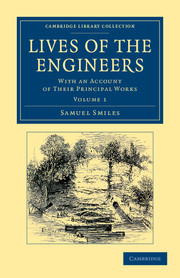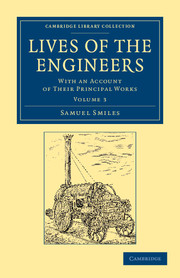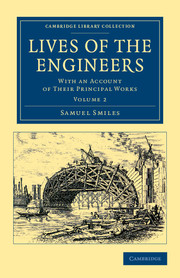Refine search
Actions for selected content:
13588 results in History of science and technology

Ether and Reality
- A Series of Discourses on the Many Functions of the Ether of Space
-
- Published online:
- 05 May 2013
- Print publication:
- 09 August 2012
- First published in:
- 1925

Lives of the Engineers
- With an Account of their Principal Works; Comprising Also a History of Inland Communication in Britain
-
- Published online:
- 05 May 2013
- Print publication:
- 02 August 2012
- First published in:
- 1861

Lives of the Engineers
- With an Account of their Principal Works; Comprising Also a History of Inland Communication in Britain
-
- Published online:
- 05 May 2013
- Print publication:
- 02 August 2012
- First published in:
- 1862

Lives of the Engineers
- With an Account of their Principal Works; Comprising Also a History of Inland Communication in Britain
-
- Published online:
- 05 May 2013
- Print publication:
- 02 August 2012
- First published in:
- 1861

John Dee's Conversations with Angels
- Cabala, Alchemy, and the End of Nature
-
- Published online:
- 05 May 2013
- Print publication:
- 13 November 1999
The Shape of Knowledge: Children and the Visual Culture of Literacy and Numeracy
-
- Journal:
- Science in Context / Volume 26 / Issue 2 / June 2013
- Published online by Cambridge University Press:
- 30 April 2013, pp. 215-245
- Print publication:
- June 2013
-
- Article
- Export citation
Introduction: Knowledge in the Making: Drawing and Writing as Research Techniques
-
- Journal:
- Science in Context / Volume 26 / Issue 2 / June 2013
- Published online by Cambridge University Press:
- 30 April 2013, pp. 203-213
- Print publication:
- June 2013
-
- Article
- Export citation
Extending the Gaze: The Temporality of Astronomical Paperwork
-
- Journal:
- Science in Context / Volume 26 / Issue 2 / June 2013
- Published online by Cambridge University Press:
- 30 April 2013, pp. 247-277
- Print publication:
- June 2013
-
- Article
- Export citation
What Is the Use of Diagrams in Theoretical Modeling?
-
- Journal:
- Science in Context / Volume 26 / Issue 2 / June 2013
- Published online by Cambridge University Press:
- 30 April 2013, pp. 345-362
- Print publication:
- June 2013
-
- Article
- Export citation
SIC volume 26 issue 2 Cover and Back matter
-
- Journal:
- Science in Context / Volume 26 / Issue 2 / June 2013
- Published online by Cambridge University Press:
- 30 April 2013, pp. b1-b8
- Print publication:
- June 2013
-
- Article
-
- You have access
- Export citation
A Writer Looking for His Writing Scene: Paul Valéry's Procedures in His Notebooks around 1894
-
- Journal:
- Science in Context / Volume 26 / Issue 2 / June 2013
- Published online by Cambridge University Press:
- 30 April 2013, pp. 305-343
- Print publication:
- June 2013
-
- Article
- Export citation
Outlining Species: Drawing as a Research Technique in Contemporary Biology
-
- Journal:
- Science in Context / Volume 26 / Issue 2 / June 2013
- Published online by Cambridge University Press:
- 30 April 2013, pp. 363-391
- Print publication:
- June 2013
-
- Article
- Export citation
Processes on Paper: Writing Procedures as Non-Material Research Devices
-
- Journal:
- Science in Context / Volume 26 / Issue 2 / June 2013
- Published online by Cambridge University Press:
- 30 April 2013, pp. 279-303
- Print publication:
- June 2013
-
- Article
- Export citation
SIC volume 26 issue 2 Cover and Front matter
-
- Journal:
- Science in Context / Volume 26 / Issue 2 / June 2013
- Published online by Cambridge University Press:
- 30 April 2013, pp. f1-f3
- Print publication:
- June 2013
-
- Article
-
- You have access
- Export citation
Industrial research at the Eastern Telegraph Company, 1872–1929
-
- Journal:
- The British Journal for the History of Science / Volume 47 / Issue 1 / March 2014
- Published online by Cambridge University Press:
- 10 April 2013, pp. 119-146
- Print publication:
- March 2014
-
- Article
- Export citation
Seized natural-history collections and the redefinition of scientific cosmopolitanism in the era of the French Revolution
-
- Journal:
- The British Journal for the History of Science / Volume 47 / Issue 1 / March 2014
- Published online by Cambridge University Press:
- 26 March 2013, pp. 15-41
- Print publication:
- March 2014
-
- Article
- Export citation
The Copernican Question: Prognostication, Skepticism, and Celestial Order
-
- Journal:
- The British Journal for the History of Science / Volume 46 / Issue 1 / March 2013
- Published online by Cambridge University Press:
- 21 March 2013, pp. 151-159
- Print publication:
- March 2013
-
- Article
- Export citation
Frank Uekötter, Die Wahrheit ist auf dem Feld: Eine Wissensgeschichte der deutschen Landwirtschaft. Göttingen: Vandenhoeck & Ruprecht, 2010. Pp. 524. ISBN 978-3-5253-1705-1. €49.95 (hardback).
-
- Journal:
- The British Journal for the History of Science / Volume 46 / Issue 1 / March 2013
- Published online by Cambridge University Press:
- 21 March 2013, pp. 170-172
- Print publication:
- March 2013
-
- Article
- Export citation
Claudine Cohen, La méthode du Zadig: La trace, le fossile, la preuve. Paris: Editions de Seuil, 2011. Pp. 342. ISBN 978-2-02040-298-9. €23.00 (paperback).
-
- Journal:
- The British Journal for the History of Science / Volume 46 / Issue 1 / March 2013
- Published online by Cambridge University Press:
- 21 March 2013, pp. 166-168
- Print publication:
- March 2013
-
- Article
- Export citation
Zur Shalev, Sacred Words and Worlds: Geography, Religion and Scholarship, 1550–1700. Leiden and Boston: Brill, 2012. Pp. xxi+319. 978-90-04-20935-0. €99.00 (hardback).
-
- Journal:
- The British Journal for the History of Science / Volume 46 / Issue 1 / March 2013
- Published online by Cambridge University Press:
- 21 March 2013, pp. 163-164
- Print publication:
- March 2013
-
- Article
- Export citation
